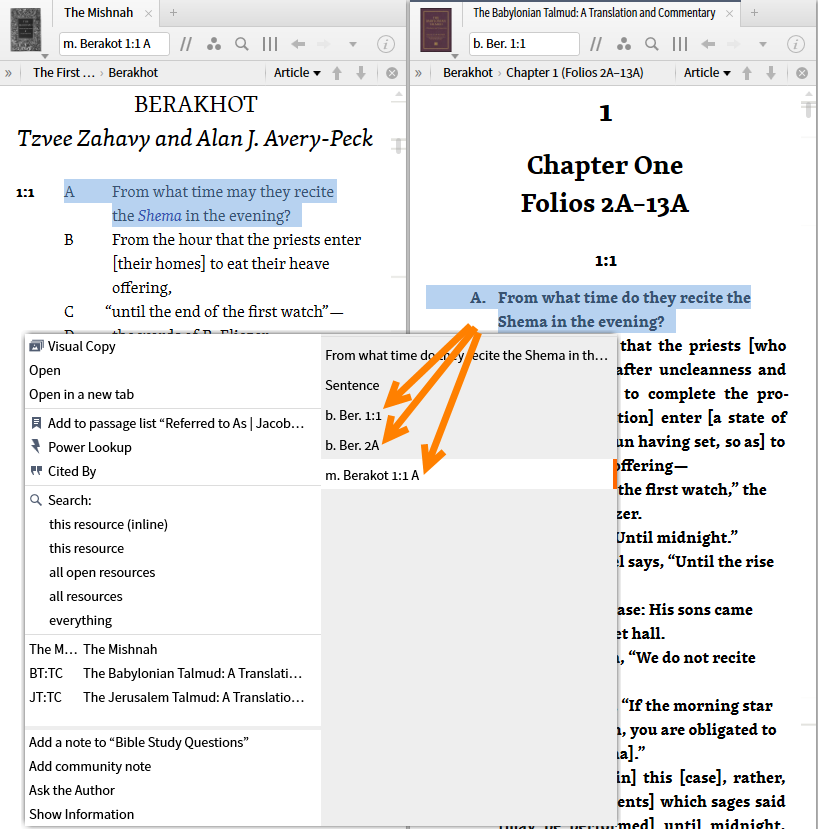Think of references to the Mishnah and Talmud as similar to Bible references - book, chapter, verse - but in slightly different terms e.g. tractate, folio, side of folio OR tractate, chapter, halachah. We will find that these have all the complications that we observed in TIP of the day: Searching on Philo. There is one interesting twist - the Mishnah text appears in both Talmuds followed by Talmudic commentary on it.
To get a basic sense of the references, these are contemporary rules as provided on Proper citation of Jewish Sources:
"Mishnah
The proper way to quote a Mishnah (abbreviated as M.) is as follows:
M. [Name of Tractate] [Chapter Number] : [Section (i.e. Mishnah)]
for example:
M. Terumot 2:3 is the Mishnah, Tractate Terumot, Chapter 2, Section (Mishnah) 3
Note: the reason why M. for Mishnah has to be stated is because the format of the Jerusalem Talmud is almost identical.
Jerusalem Talmud
The principle should be established that the Talmud written in the Land of Israel from the period of 220 CE until c. 400 CE should be called the Jerusalem Talmud (abbreviated as J.T.). The proper way to quote the Jerusalem Talmud is as follows:
J.T. [Name of the Tractate] [Chapter] : [Halachah]
for example:
J.T. Sheviit 1:6 would be the Jerusalem Talmud, Tractate Sheviit, Chapter 1, Halachah 6
Babylonian Talmud
The proper way to quote the Babylonian Talmud (abbreviated B.T.) is as follows:
B.T. [Name of Tractate] [Folio (i.e. daf) number] [Side of the Folio, i.e. a/b]
for example:
B.T. Berachot 4a would be the Babylonian Talmud, Tractate Berachot, Folio 4, front (a) side"
Mishnah
1. As usual, the best way to learn the reference system is by the entry in the reference box and by the context menu. One can then use the context menu to build a search argument.

2. Notice that the search is built with an =, a precise match rather than the default ~ which includes subsets and overlaps.

3. Switching the datatype operator to the more useful ~ we get 101 results in 86 articles in 58 resources that reference this passage of the Mishnah i.e. Berakot (tractate) 1 (chapter) : 1 A (section).

4. Note that in the Jerusalem Talmud, one of the references lacks the Tractate name - whether a Logos typo or a printed copy typo I don't know - but because the search is on datatype reference, the reference is still picked up. But it is important to remember any time you use a <datatype> reference you are searching Logos tagging not the surface text.

Babylonian Talmud: Mishnah portion
5. When I highlight the same text in the Mishnah portion of the Jerusalem Talmud, I am given three separate schemes to identify the passage ... schemes that cover differing lengths of text. You may think of it as somewhat parallel to specifying a verse or a pericope/chapter.

6. Each of the reference schemes finds matches only from resources coded in that scheme ... no equivalent to Biblical verse mapping here. But note that the rightmost Search is specified as Mishnah not as Talmud, reflecting the fact the the Mishnah text is included in the Talmud.

7. A description of some of the variants in references systems from Instone-Brewer, D. “Rabbinic Traditions and Writings.” Edited by Joel B. Green, Jeannine K. Brown, and Nicholas Perrin. Dictionary of Jesus and the Gospels, Second Edition. Downers Grove, IL; Nottingham, England: IVP Academic; IVP, 2013.

8. Again one may wish to replace = with ~

9. Because each of the searches above have unique results, to get the entire set of results one must combine them into a single search. I'm thinking that if would be useful to have a built in function for this rather than the copy & paste routine after running 3 individual searches. It makes more sense to run a single search for all three. However, remember that they reference varying lengths of text.

Jerusalem Talmud: Mishnah portion
10. The Jerusalem Talmud functions in the same manner as the Babylonian Talmud - including three reference schemes.

11. Again they yield difference results in a search for references. Again one is a Mishnah format.

12. Again swap ~ for =.

Babylonian Talmud: commentary portion
13. The talmudic commentary in the Babylonian Talmud is coded with only two schemes.

14. When the individual searchas are initiated from the Context Menu, one finds no results so for the = datatype operator there is no need to combine results or search arguments.

15. Using the Milestone extension, I can search for the occurrences of the actual text in my library (or commentary indexed by the text).

16. The Milestone extension is useful for:
- searching for particular word or phrases in the Talmud text
- searching for Bible references (a datatype) in the Talmud text
- searching for internal cross references (a datatype) in the Talmud text
- and many similar searches

17. One may select a larger unit of text ... here I selected 4 paragraphs. Note that in the "through" format there are no spaces on either side of the hyphen.

18. A search on the multiple paragraphs with ~ inserted for =.

19. Similarly larger sections of text can be combined in the "through" format.

Jerusalem Talmud: commentary portion
20. Everything shown about the Babylonian talmudic commentary also applies to the shorter Jerusalem Talmud.
